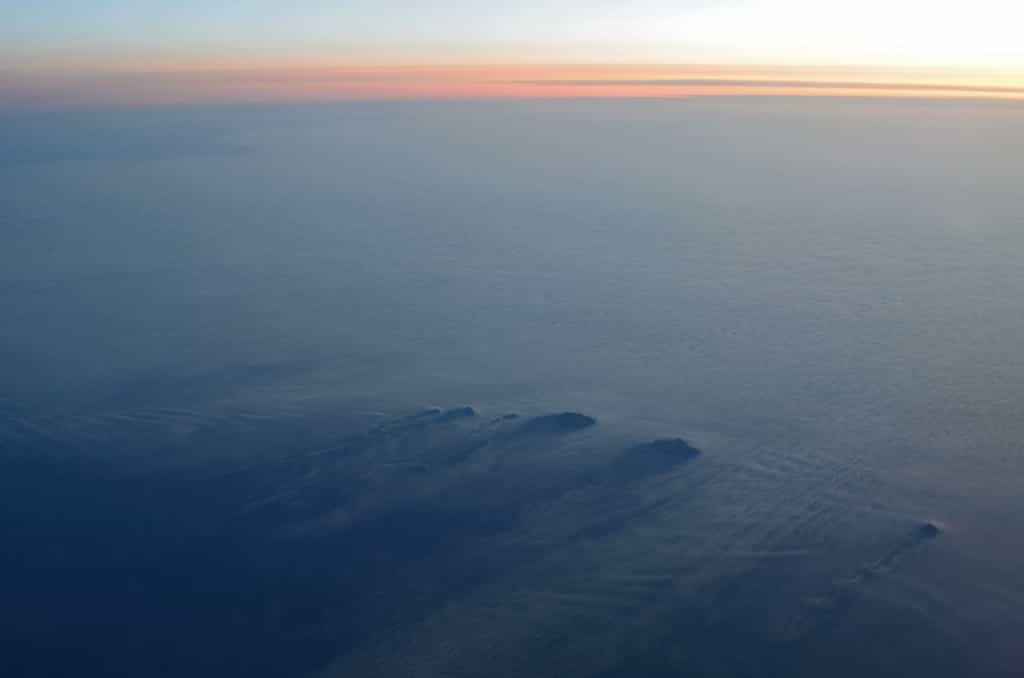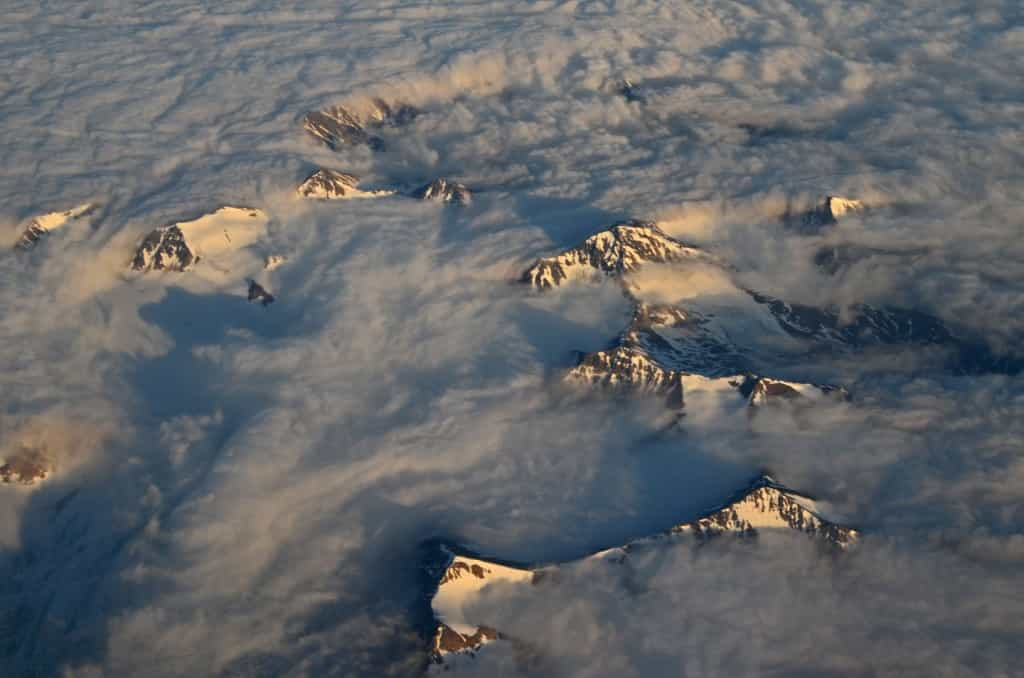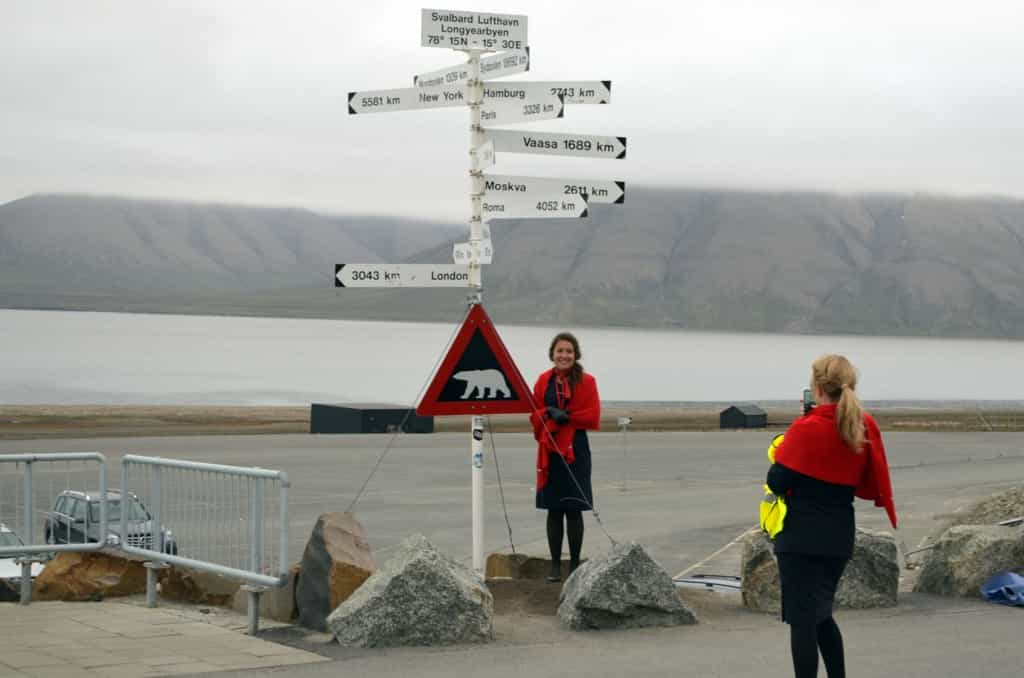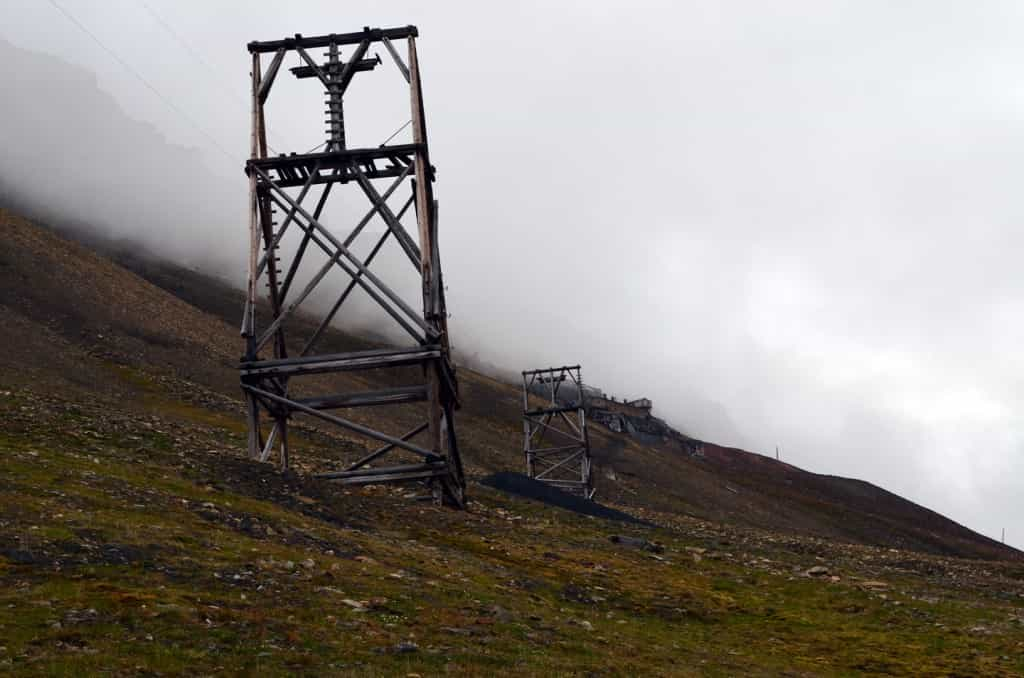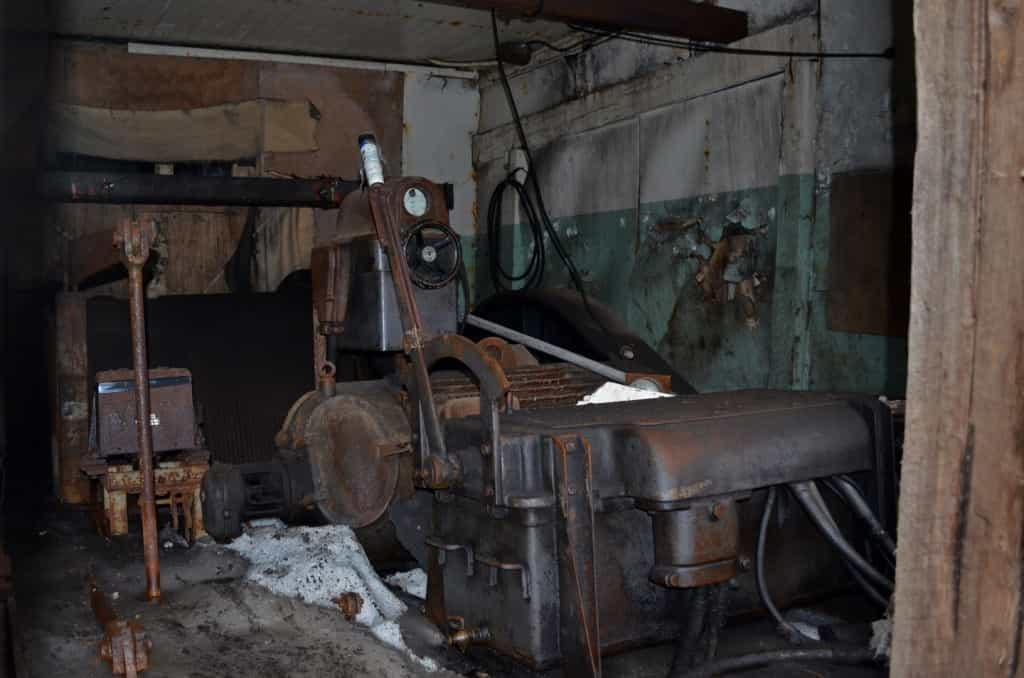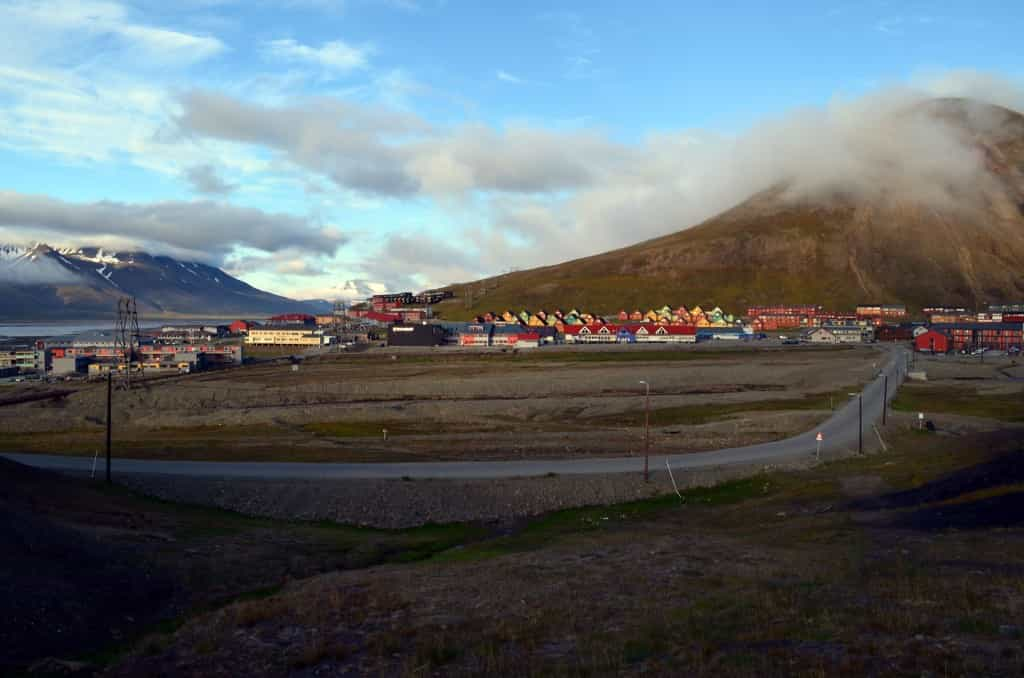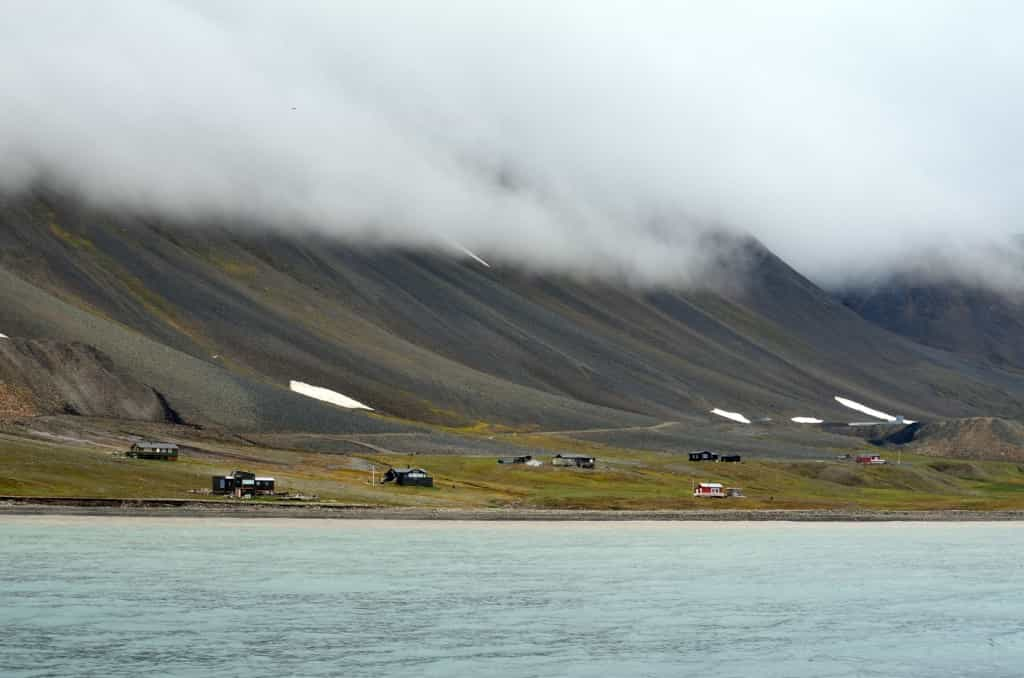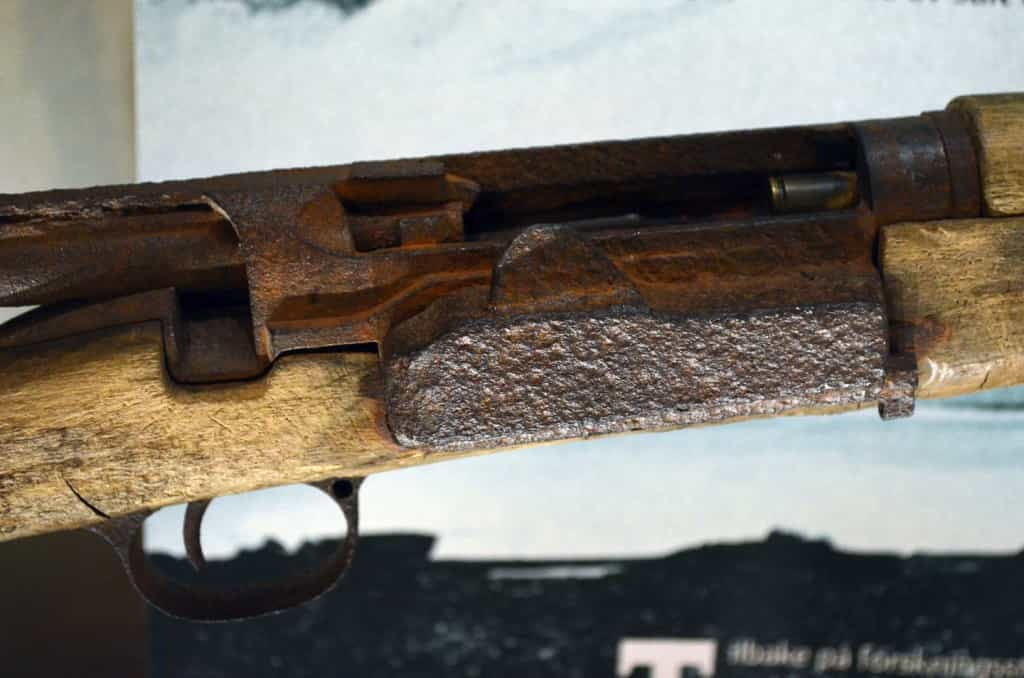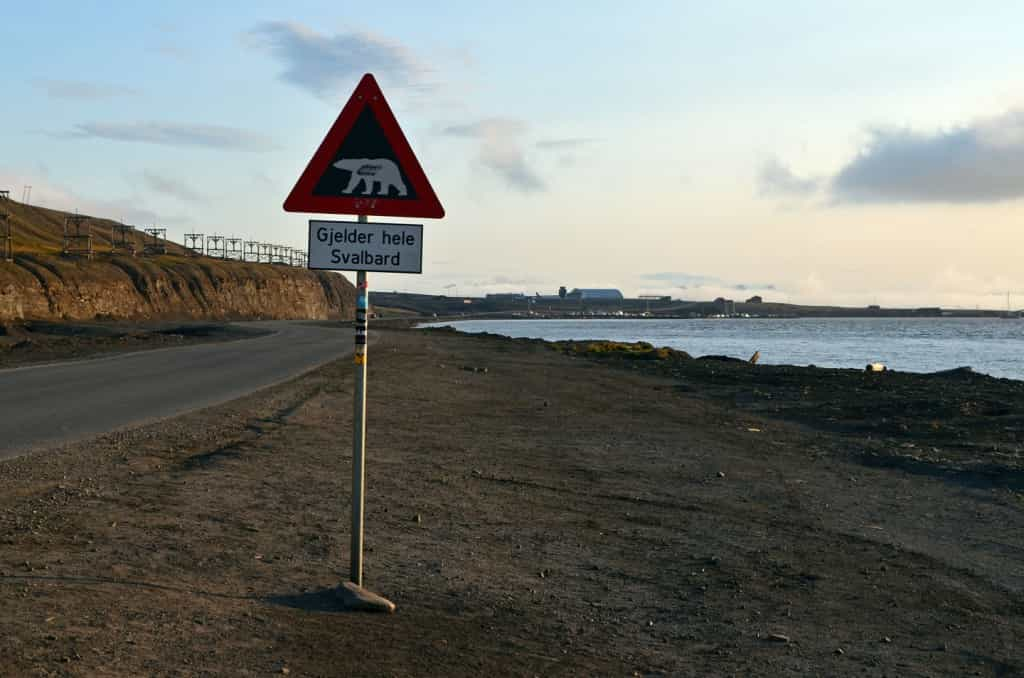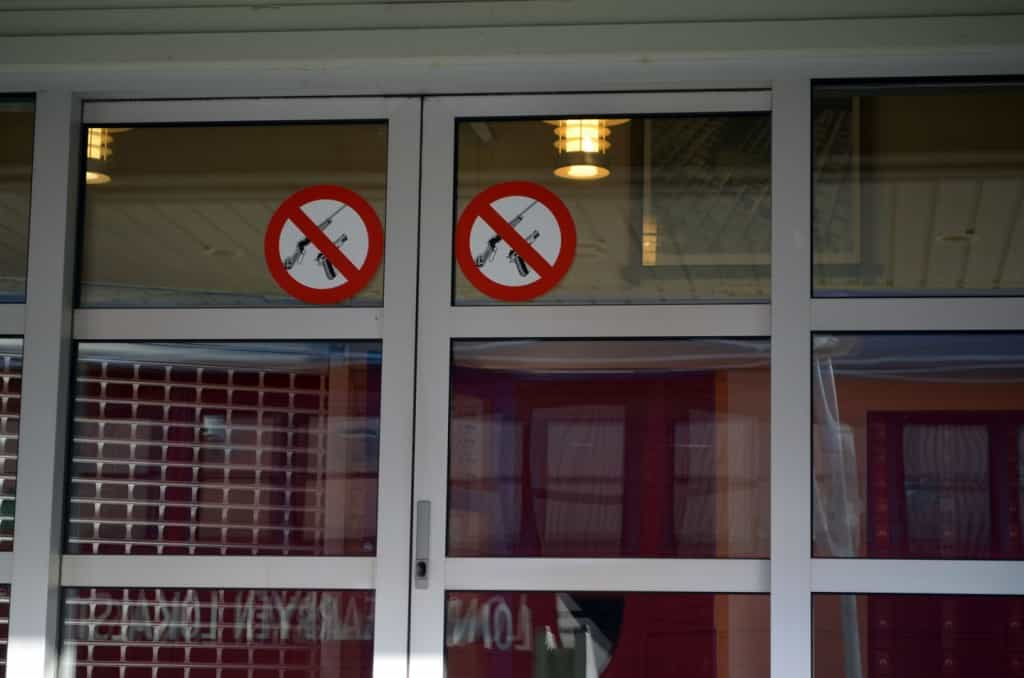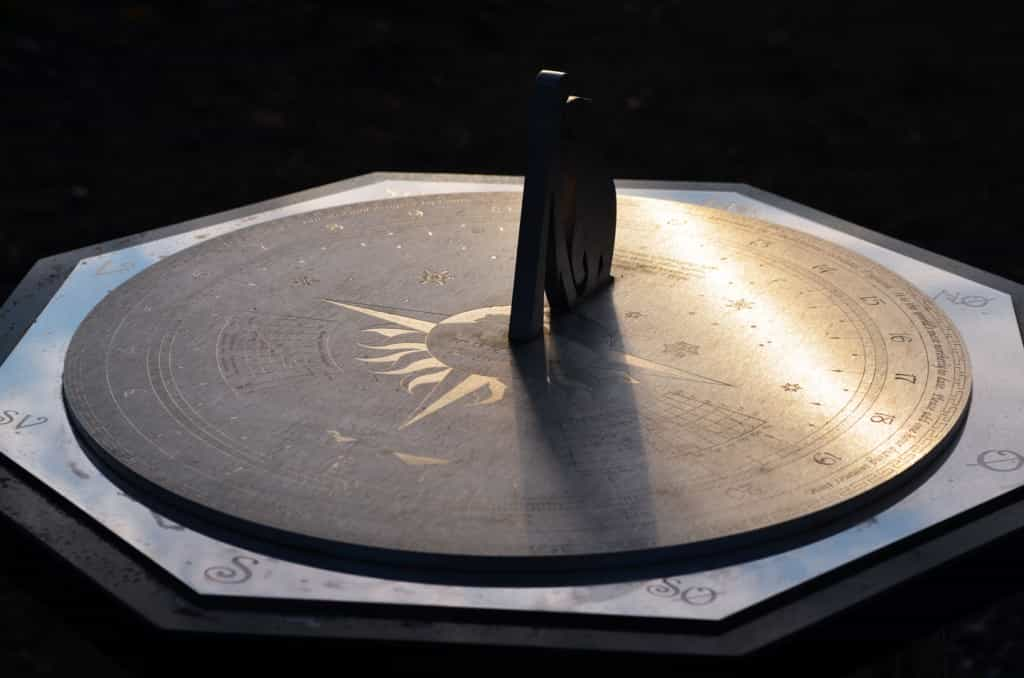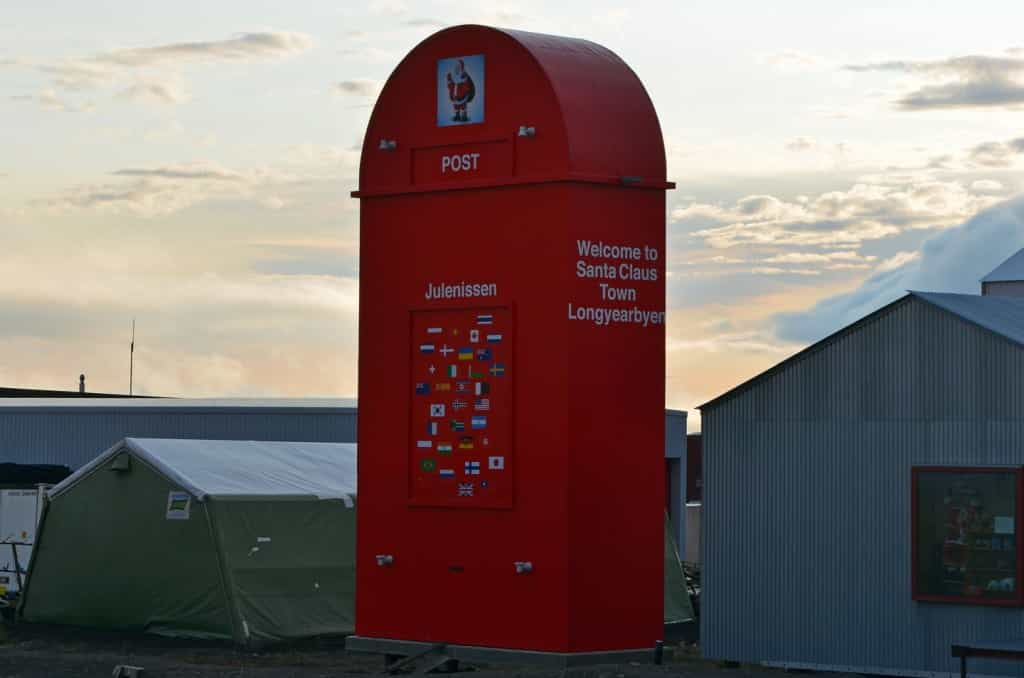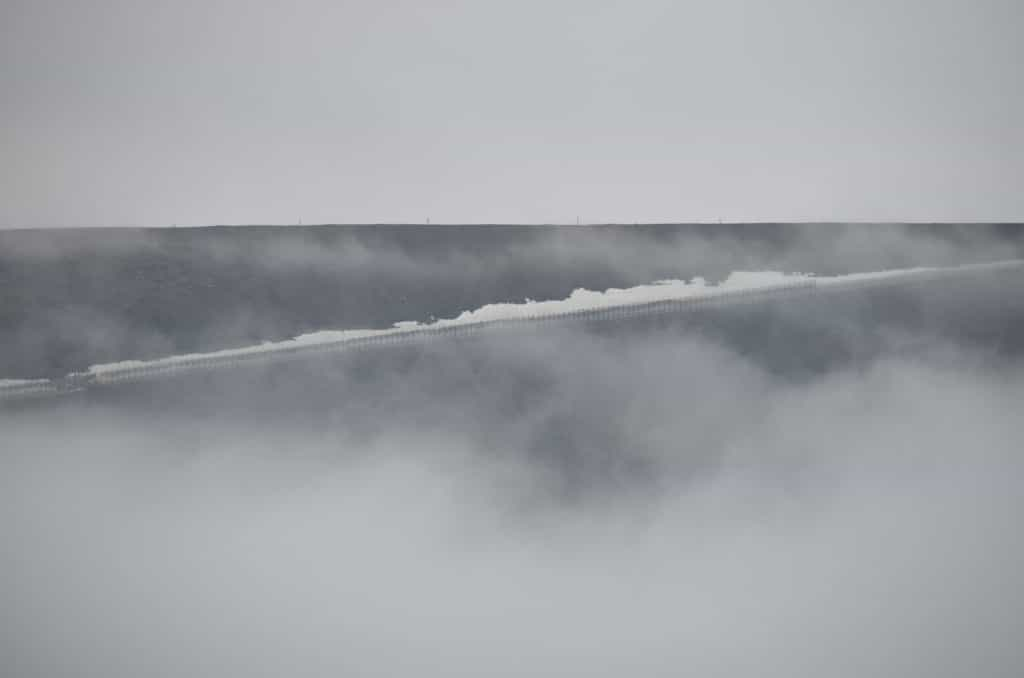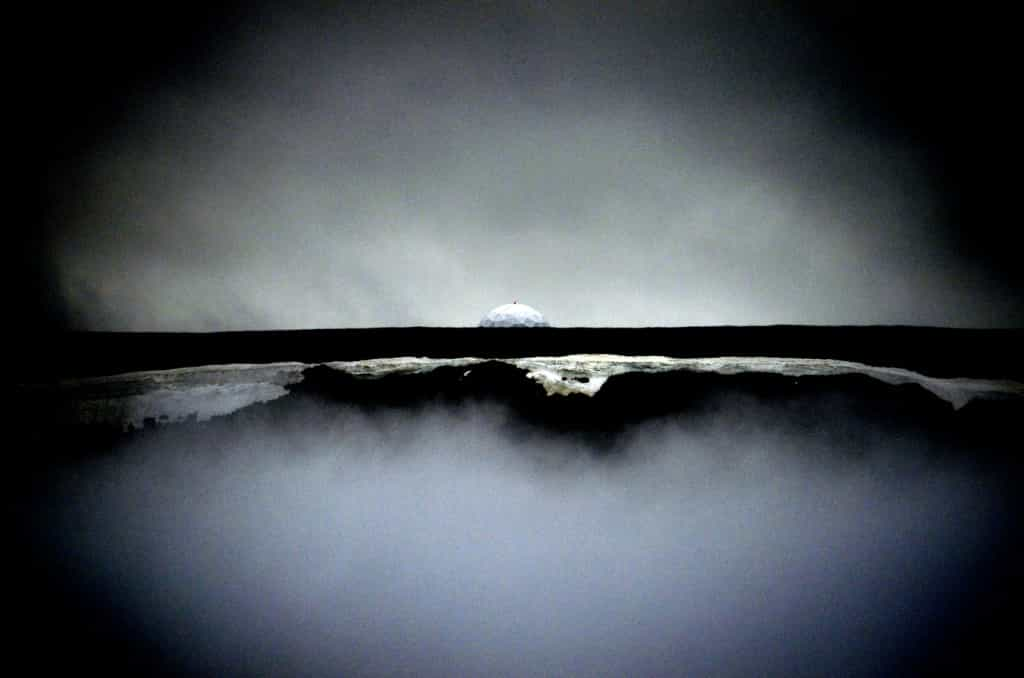The amazement of a visit to the northernmost town on the planet begins well before landing.
Flying 3h straight north from Oslo, in July one sees the early signs of the midnight sun, as it begins to rise around 23:30, as you move further and further north. Down below, mysterious peaks of northern Norway break through the low clouds.
Two hours later, any sign of a red horizon are gone, as the sun never gets low enough to produce that effect in the summer. Below, the barren, isolated and remote mountains of southern Svalbard. I couldn’t help but think that this was certainly not the best place to contemplate an emergency landing.
You know you are in an unusual place when the flight attendants on a return flight bother to get out of the airport to take “me in front of” pictures!
So, why do people live here? In the first few centuries, people didn’t really “live” here; they trapped furry animals, harvested whales and eventually, extracted coal. Nowadays, coal is the main industry, along with tourism and Arctic scientific research of all kinds. There is also a political reason which I will get into later. But first, coal.
Although very rich in oil and gas, Norway gets nearly all of its electric power from hydroelectric dams. This is the only coal power plant in the entire country. There is only one mine left, well outside of town. What doesn’t get burt gets exported to Germany. A very high quality, carbon rich coal, it is not used for energy, but rather combined with iron to make high quality steel for the German automotive industry.
In Longyearbyen, the signs of old style mining are still all over the place. Before trucks started doing the job, coal would move in cable-suspended buckets, along these pillars. At the end of the line, you can see Mine 2b, aka “Julenissegruva” or “Santa Claus Mine”.
I am always attracted to strange or desolate places, and this abandoned shaft was no exception. It looked so mysterious as I photographed it high on the cliff with my telephoto lens. Luckily, the people of Longyearbyen are not into babysitting. They told me there was a danger of falling stones and that the buildings were not maintained and possibly unstable. So the bottom line? “Be careful” and not “Don’t go”.
Good enough for me. And off I went.
The transport system worked exactly like a ski lift.
While not claustrophobic, I have to say I found the actual mine entrance a little scary. Not sure why, but there is certainly something eery about it. Obviously, I wasn’t about to crawl in, but I did take a peak.
Collapsed support beams, ice and a sealed entrance. Not very welcoming. If you were to break through the seal, you would likely face tens of kilometres of partially collapsed tunnels and an unbreathable atmosphere rich in methane. So maybe next time, when I bring a flashlight.
A lot of the heavy machinery is still around, but I avoided entering any of the buildings.
This elevated walkway had fresh muddy footsteps on it, so people clearly go in the top room. With no local advice, going into an unmaintained, partially collapsed structure on stilts, perched high on a steed and deep rocky ravine did not seem like a super good idea. After all, was a collapse possible?
The next building had an eloquent answer to that question. But that is the past.
This is the present, modern Longyearbyen. Originally a pretty rough outpost dominated by men on contracts, the town began to change in the late 60’s, when the Norwegian Government decided inhabitants should have access to a comparable level of service as people on the mainland.
You might wonder why the town’s main pedestrian shopping street is so deserted? As I alluded to, every year at 23:45, on the 17th of April, the sun rises, and then it doesn’t set again until 23:12, on the 24th of August. I took this picture at 1:30 am!
The town again, seen from the World War II memorial. While not that strategically important, Nazi Germany deployed great efforts to capture it, probably because at that time in the war, they needed the good news of some sort of victory.
The town is home to about 2,000 people, with a few hundred permanent, Longyearbyen-born residents, and a lot of contractors, scientists and other temporary residents. The population of actual long-term resident families really increased in the 1970’s, after the construction of the airport broke the near total isolation that could occur in winter whenever the bay froze. Before people where so isolated they would get sick from the mail they received, having no immunity to the simple cold or the flu. The enormous school, the arts centre, the university campus, are all signs that the promise of providing services to the town were not only met, they were well exceeded. Today it has far more services than a normal town of the same size in mainland Norway.
So why? Because it is a claim to Arctic rights, present and future. While the coal mine operated by contractors in rough living conditions might be economically viable, Oslo subsidizes the settlement for strategic and political reasons. Nevertheless, tourism helps make it less of a money pit, as upwards of 30,000 people visit every year, mostly in the summer. And as I mentioned, the place is also a major centre for Arctic research and provides support to remote scientific outposts.
Amusingly for such a small place, many locals have cottages, to “get away from it all”! These ones are only about 6 km from town. They are considered to be top luxury cottages, because they are close enough to be connected to the town’s internet system.
Because I spent my days on excursions, I had little opportunities to meet locals. I really wish I could have stayed an extra day. So to learn more about the history of the place, I went to the museum.
It had a reading room that would make Eastern Canadians proud: wall to wall seal skin!
Coal deposits are usually no more than a meter thick here. Before the days of mechanized mining, this meant the terribly difficult work conditions depicted in this life-size model.
Look closely, and you will see a stuck cartridge in this rifle’s chamber. It was found in 1965 and belonged to hunter and trapper Georg Nielsen, who disappeared in 1921.
Next to the rifle, the broken bones of Nielsen and his three comrades were found. A stuck cartridge can be a fatal event in this harshest of environments. While deadly encounters occur with many different animals, I believe the polar bear is the only one who will make the deliberate decision to hunt humans as prey.
When the Spanish and the Portuguese dominated the world with their American possessions, some nations such as the Netherlands looked North for new opportunities. This happened as early as the 16th century, and I was awed to see illustrations depicting men in early renaissance costumes fighting polar bears with spears and halberds.
Luckily, this is the only one I saw, but still today, it is forbidden to leave the settlement unarmed. A local tourist map, the kind that would usually say: “Don’t leave valuables in your parked car”, read: “Don’t leave the settlement without suitable weapons and experience in how to use them”.
I did venture outside the zone unarmed, but it was in this case very safe. I only covered the 4 km between the town and the airport, in a season where the absence of ice has caused the bears to move far away. Furthermore, just before a flight is arriving and leaving, there is constant traffic on the road and with the snow gone, a polar bear can be spotted from very, very far away.
Banks and shopping malls won’t let you come in armed, but they all have a place to check-in your guns.
The only large animal I saw would not have required a lot of firepower to keep me safe. Unlike dears in Canada, reindeers in this part of the world are very docile and don’t get spooked unless you approach very close.
Now some funny and quirky things about the northernmost town on Earth. First starting with some rules. Longyearbyen possibly has the strangest alcohol laws in the world. The settlement used to be a very manly town, heavily segregated between the miners who lived amongst themselves in barracks, and the managers and government officials who lived with their wives and families. Alcohol was banned. Eventually, the policy was relaxed and alcohol was introduced, with a quota system, to keep workers sober. Workers drank beer and hard liquor, and today both remain controlled. As a resident, you can only buy 2 bottles of liquor and 24 pints of beer a month. Notwithstanding any partying, this is not even enough if you enjoy a single pint of beer before dinner, as you will be left dry for a full week.
However, old school workers did not drink wine, which was both unmanly and probably expensive. But the wives of the notables did drink wine. Men of intelligence, education and leadership, they obviously realized that taking the wine out of the hands of the wives they had dragged to the end of the world was probably a very stupid idea, so wine was off the quota system. Incredibly, it remains so today, so while one can only have a single pint a day, 24 days a month, drinking 3 bottles of wine everyday is not only perfectly fine, it is also completely tax-free! As a visitor, I was explained the complex procedure by which I could buy beer or liquor, by presenting a paper plane ticket out of Longyearbyen, which would be stamped and whatever, etc, etc… Incredulous, I asked: “What about wine?”. “Just grab it and pay at the cash”, came the answer!
The sundial, which for 4 months a year works 24 hours a day.
In these mining towns, removing your shoes before entering any building is the norm, and the Radisson BLU Polar Hotel is no exception. Notice the lack of leather patent shoes and stilettos.
Parking spots all come with power cords.
But parking the snowmobiles is the main problem. Since there are about as many of them as people, in the short snow-less season, they are pilled up everywhere.
If you wanted to, you could take a whole bunch of pictures that would make Longyearbyen look like an abandoned dump. I gather this is because when they build a new structure, they don’t bother to demolish the old one, because available space is everywhere and demolition is therefor unnecessary and expensive.
At the bottom of the hill, a small cemetery. It is old and has no modern equivalent. Today even if you are a permanent resident, you cannot be buried there and the body must be taken back to mainland Norway. This is not without reason. Occasionally, the action of the permafrost, the erosion and the generally dynamic geography causes corpses to, well, be returned to the villagers by the ground. Not a super positive experience for the relatives.
Also, one cannot retire in Longyearbyen, even if you live there all your life. I should rather say, one cannot retire once one looses his autonomy. Although a lot of services are provided in town at great expense by the Norwegian Government, assisted living facilities were deemed a bridge too far.
And finally, the mysterious. Along this road between cloud and skies, the Svalbard Global Seed Vault, where close to a million different varieties of plant seeds from all over the word are kept in massive concrete vaults under the permafrost, at about -18 celsius, as protection against global catastrophes or the permanent extinction of certain kinds of plants.
More mysterious still, the antenna array at the summit of the plateau. They were almost impossible to see in the fog, but I heavily Photoshopped this telephoto shot to make one come out. Built to capture the data from satellites on polar orbit, the array has recently grown to more than 40 antennas. It is connected by an undersea cable to some military facility on mainland Norway. To avoid any damage from fishing or other commercial operation, the location of the cable is on nautical charts.
But now, as the array expands, a new cable is about to be laid, and the itinerary is classified. Allegedly financed by NASA, the expansion of this capability must be to better protect critical information about ice caps and polar bears. I have no reason whatsoever to suspects other agencies are involved in the project.
But if you think this is strange, wait until the story of my visit to Barentsburg, the nearby Russian settlement.
#Norway

